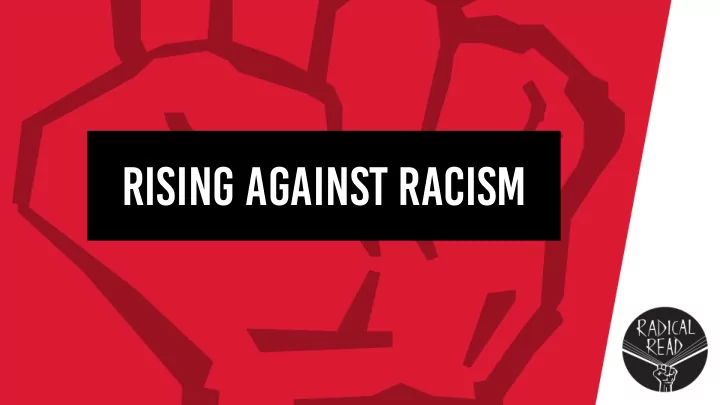

Rising against racism
Learning Objectives Learn about the ways in which racism has existed in different • societies by looking at two case studies- South Africa under Apartheid and the United States of America today. Find out about how protests developed in Soweto and Ferguson, • and the long-term and short-term causes of these protests. Examine how violent responses from the police shaped these • protests. Encourage reflection on how we can all support people • struggling against inequality.
Soweto Uprising - background Soweto Uprising - background From 1948- early 1990s, South Africans lived under a regime known as Apartheid Apartheid In Apartheid, black people had less rights than white people. They worked harder jobs for less money, and were restricted to living in certain parts of the country, such as Soweto ( So uth We st To wnship ). They could not take part in national elections or vote. The education system was completely different for white and black students, who went to different schools.
A play area reserved for white children (Three Lions/ Getty Images)
Soweto Uprising Soweto Uprising The government passed a law known as the Afrikaans Medium Decree of 1974 which forced all black schools to have lessons taught in Afrikaans. Afrikaans was the language of the white communities of South Africa. Previously black schools had taught in English, which was used by different black African communities in the country. This was very unpopular - it meant many black African teachers would be fired, and could prevent black Africans from being able to seek work abroad. The Soweto Students' Representative Council called for all students in the area to walk out of their classes and march to the Orlando Stadium in protest on June 16 th , 1976. Police fired live ammunition and teargas at the students, killing four, and sparking three days of protests and riots across the city.
(Sam Nzima) Hector Pieterson was one of the children killed in the first wave of police violence. His death outraged many people, inspiring them to join the protests.
Soweto Uprising Soweto Uprising Started by school students, the protests soon enveloped the entire local community. Black protestors attempted to shut down government buildings and attack government-run beer stores. The police responded with further violence, killing over 176 people.
After the uprising, the government made it more difficult for black people to protest, leading many to join secret, underground groups such as the African National Congress. For many people, it became a symbol of the importance of resistance and got them involved in activism. In 1979, the compulsory use of Afrikaans was ended, but the segregated education system continued. The anniversary of the uprising, June 16 th , is now a public holiday in post-Apartheid South Africa, called Youth Day.
Black lives matter Black lives matter #Blacklivesmatter began as a hashtag on social media, and has developed into an international political movement. Silvercloud) Launched by three black (Johnny Silvercloud (Johnny women, Patrisse Cullors, The three women began using the hashtag after George Zimmerman, Alicia Garza, and Opal who shot and killed the unarmed black teenager Trayvon Martin in Tometi, the campaign aims 2012, was declared not to have committed a crime in July 2013. to promote equal rights for people of colour and The hashtag went viral, and the women formed a network of activists challenge racism globally. who would protest against racist police violence and to improve the conditions of people of colour.
Black lives matter Black lives matter The Black Lives Matter movement became more widely-known after two high-profile killings of unarmed black men in 2014: Eric Garner and Michael Brown. In both cases, the police officers involved in their deaths were not charged with any crime.
Black lives matter Black lives matter These images were made by artist Shirin Barghi, and commemorate the last words of those killed by the police. www.shirinbarghi.com
Ferguson In Ferguson, Michael Brown was shot dead by police on August 9th, 2014. This led to an immediate wave of protests which included both peaceful and non-peaceful actions by different groups of people. The police used violence against crowds in a way which was criticised by many. Protestors and journalists who were present said that peaceful crowds were being attacked by the police. The police claimed their actions were necessary to prevent looting. The protests continued throughout August and September, and would grow bigger after reports that other unarmed black men had been shot by the police in other parts of the country.
Ferguson (photograph taken of Edward Crawford throwing a teargas canister away from protestors, taken by Robert Cohen)
‘Am I next?’ Ferguson Ferguson's Protests Through the Eyes of a Teenager | TIME’ Film Link: youtu.be/KuqV1FwMws4
Thanks to Funders and Partners: Written and compiled by Dr Daniel Edmonds, danieledmonds237@gmail.com
Recommend
More recommend